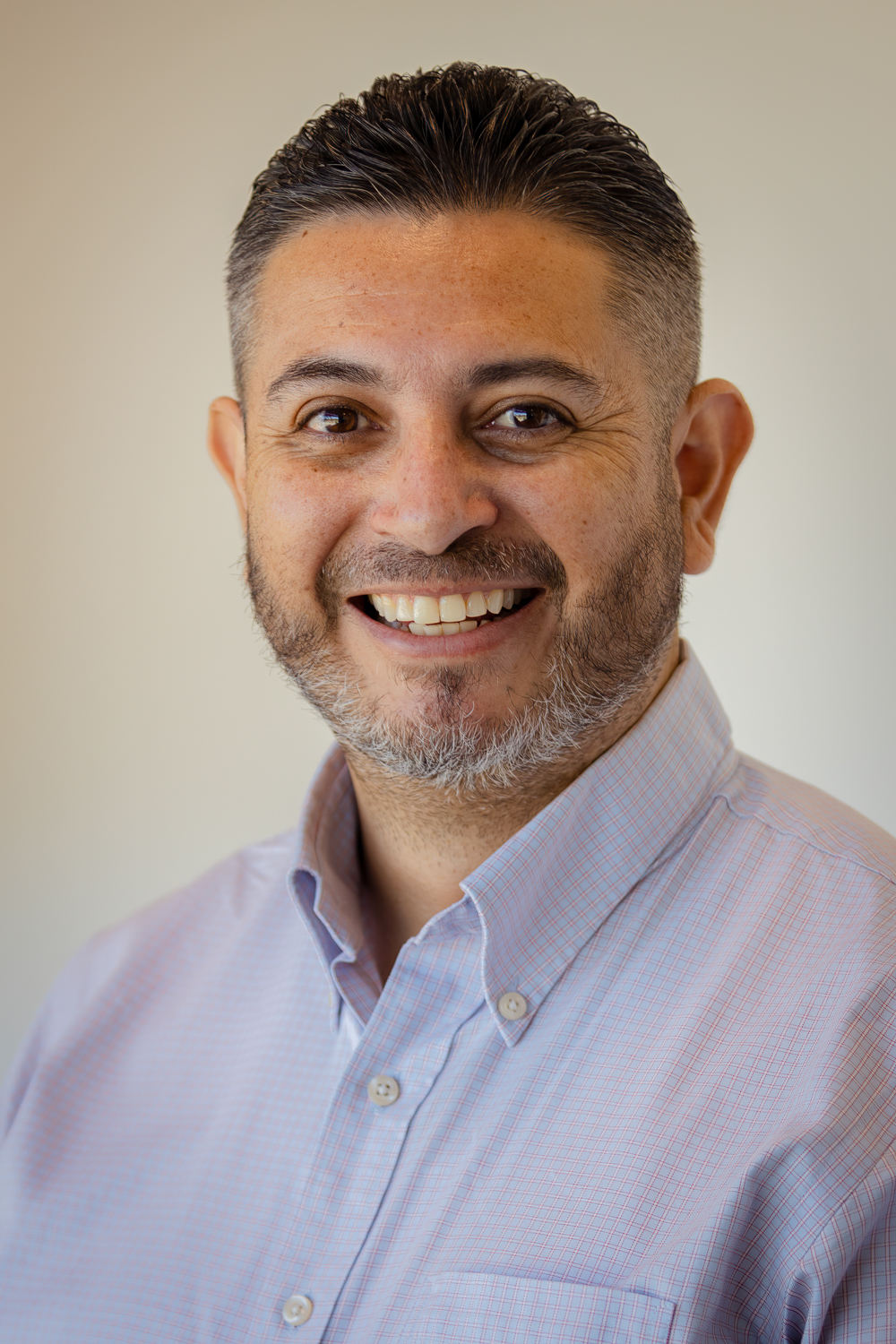

Growing up in farmworker housing outside of Merced, California, as the oldest of four siblings, Jesus Cisneros didn’t even know what college was until a teacher told him it was something he should consider. He applied in secret, against the wishes of his father who didn’t think the family could afford having him live away from home.
When he got to UC Berkeley, “It was a total culture shock. I’d never lived in the city, didn’t know about what a research university was, didn’t know any of the expectations or conventions.”
Getting to college and then on to graduate school, he said, “was like going through a corn maze. I couldn’t see where I was going but I just had to keep pushing my way through.”
Today, with a bachelor’s degree from UC Berkeley and a master’s from UC Merced, he is determined to help guide the way through that maze for others. As assistant dean of UC Merced’s graduate division, he leads a program that helps students from underrepresented minority backgrounds navigate to and through graduate school and kick-start faculty careers.
“When I was growing up, I had never met somebody with a master’s degree that looked like me, much less somebody that had a Ph.D. that looked like me. Now, to be able to go out into my community and show them what’s possible, it’s the most wonderful thing ever. You see the students light up and you see that click that says, ‘I can do this myself,’” Cisneros says. “Mentors and teachers need to reflect the students they serve.”
Boosting diversity in a post-affirmative action era
As the demographics of California have changed, UC has made a conscious effort to cultivate a student, staff and faculty community that reflects the state it serves.
Since 1996, the university has been prohibited by law from using race as a factor in admissions, so it has worked to expand diversity and inclusion in other ways, including increased outreach to K-12 students and schools, more holistic admissions practices, increased multicultural resources on campuses, and programs to cultivate a faculty that better reflects California students.
UC’s efforts are paying off: 31 percent of this year’s incoming undergraduates are from underrepresented groups (Black, Latino, Native American and Pacific Islander), up from 20 percent a decade ago.
UC President Michael V. Drake, M.D., has set even more ambitious goals, calling for the University of California to become the first higher education system in the nation to have each of its undergraduate campuses attain status as minority-serving institutions — a federal designation for achieving enrollment targets for specific underrepresented groups.
As part of that, UC is closing academic achievement gaps that disproportionately affect underrepresented and first-generation college students. It is investing in efforts to strengthen ties in communities of color, provide students with opportunities to take their academic careers further, and ensure that UC campuses, labs and medical centers provide a supportive environment where everyone feels valued and welcome.
| 2002 | 2007 | 2012 | 2017 | 2022 | |
|---|---|---|---|---|---|
| Total URM | 26,259 (17%) |
31,845 (19%) |
45,875 (25%) |
62,786 (29%) |
70,210 (30%) |
| Latino | 19,985 (13%) |
25,020 (15%) |
37,345 (20%) |
52,360 (24%) |
58,404 (25%) |
| Black | 4,622 (3%) |
5,316 (3%) |
6,810 (4%) |
8,710 (4%) |
10,124 (4%) |
| Native American | 935 (0.6%) |
895 (0.5%) |
1,281 (0.7%) |
1,174 (0.5%) |
1,149 (0.5%) |
| Pacific Islander | 717 (0.5%) |
622 (0.4%) |
435 (0.2%) |
542 (0.3%) |
533 (0.2%) |
| Total Undergraduates | 154,541 | 167,327 | 183,198 | 216,747 | 230,407 |
View a downloadable image of this table.
Here are nine ways UC is working to achieve its vision:

Jesus Cisneros, assistant dean of Graduate Education, UC Merced
1. Federal designations — and the resources that come with them
Five UC campuses — Riverside, Santa Cruz, Merced, Irvine and Santa Barbara — are federally recognized as Hispanic Serving Institutions (HSIs). Among other criteria, that means that Hispanic and Latino students make up more than a quarter of the population. The remaining four undergraduate campuses are on pace to soon follow suit.
When UC achieves that distinction, it will be the first system in the nation to do so, an especially noteworthy milestone, given that it has such highly selective schools.
The university is also working to achieve designations across its campuses as Asian American and Native American Pacific Islander-Serving Institutions (known as AANAPISIs).
The designations are more than bureaucratic alphabet soup: They bring in federal dollars for programs and resources that not only help the designated groups, but foster academic success for all students, regardless of race or ethnicity, such as improved graduation rates and timely completion of college.
The entire student body benefits in other ways, too. All undergraduates at federally recognized HSIs and AANAPISIs are eligible for fellowships, internships and educational programs across the U.S. that will advance their academic and career prospects. For students considering attending UC, the designation also provides reassurance they’ll find a diverse community that supports their success.
Learn more about UC’s HSI Initiative and how it benefits all students.
2. A 90 percent graduation rate for all students
In 2022, UC celebrated the largest and most diverse graduating class in its 154-year history.
Now, the university is redoubling efforts to make sure all those who walk in through its gates walk out with a diploma — and do so in a timely manner.
Students from underrepresented groups already graduate at high rates, relative to national averages, but low-income and first-generation college students lag behind other student groups in the proportion that earn a degree and how long it takes them to achieve it.
By 2030, the university aims to close these gaps by investing in research-tested academic support programs such as summer bridge, targeted orientations, living-learning communities and first-year seminars.
“Our goal is a 90 percent graduation rate for students of all demographic groups,” said Pamela Brown, UC Vice President for Institutional Research and Academic Planning. “We know our students are capable of this. We just need to give them supports to do so and to build and invest in programs that have been proven to work.”
3. Admissions policies that look beyond grades and test scores
The University plans to increase enrollment of California students by at least 23,000 students by 2030 — the equivalent of a new UC campus. And as enrollment numbers grow, UC is working to continue its growth in underrepresented students.
UC uses a holistic approach to admissions, understanding that a student's readiness and potential contributions must be measured by the sum of their experiences, circumstances, qualities and achievements. This includes looking beyond grades and test scores to see how a student has overcome obstacles and taken advantage of the opportunities available. It’s part of a concerted effort to provide a more level playing field for students, regardless of ethnicity, income and other factors out of a student’s control.
In 2022, UC became one of the first universities in the country to stop considering standardized tests as a factor in admissions.
That’s helped a broader array of students consider UC, including those who don’t have the resources to help them prepare for standardized tests, or ready access to test sites.
In 2022, record numbers of California students, including those from underrepresented groups, applied to UC’s nine undergraduate campuses.
4. Near-peer advisers in K-12 schools
Starting as early as middle school, UC is at work in K-12 schools across the state to help students gain the academic foundations for college and envision it as within their future.
UC’s college prep programs empower students through academic preparation programs, hands-on research, and support from mentors and college advisors in their community, many of whom are themselves recent UC grads. As college application time nears, students get help with applications and financial aid, and have opportunities to meet and talk with new UC grads from their own community.
“Families relate to me. They see that if I did it, they can do it too,” said Christina Gonzalez, a Class of ’18 UC Merced graduate who is now an adviser in Merced-area high schools. “My hope is to help make it so going to college seems like a normal experience that is for everyone. It’s not just for the high achievers.”
Last year, UC’s outreach program reached more than 162,000 students and 26,000 parents and guardians in communities with low college-going rates — helping send the message that a UC education is within reach.
5. Deepening community partnerships
It’s not enough to provide students with practical support to get to college. Families need to feel that the school will be a welcome environment, where their child will be safe and thrive.
To build that trust, UC has forged relationships with organizations with deep roots in local communities around California, including churches, Boys and Girls Clubs and local parents’ groups.
“Parents tell us, I’m not just worried about my student getting in, I’m worried about their social and emotional health when they get there, “said Sandra Williams-Hamp, executive director of Outreach and Educational Partnerships at the UC Office of the President, who works to build partnerships in diverse communities. “We have to show up where our families are, and we have to show them we want them here.”
The Council of African American Parents, which just celebrated its 30th anniversary, partners with UC on everything from bus tours to UC campuses to essay boot camps and college information nights. It has sent thousands of students to UC campuses over the years.
Recently, UC has established promising efforts with A2Mend African American Education Network and the San Diego Collaborative, a group of 25 organizations serving the Black community that includes the “Divine Nine,” the Black Greek letter sororities and fraternities that make up the National Pan-Hellenic Council (NPHC).
“Changing our trajectory with Black students and other historically underrepresented groups requires a community strategy that is intentional and continuous,” Williams-Hamp said. “We have to build that trust over time and by showing up over and over again where students and families are. We are excited to share with students the multiple pathways to UC and the power of a UC education.”
6. Stronger programs to support transfer students
One in three students who earn a UC degree start their education at community college. Many of these students have served in the military, raised children, held down full-time jobs and careers, are new arrivals to the United States, or have overcome early academic and personal struggles to excel in community college.
Over the last decade, UC has streamlined the transfer process and strengthened partnerships with community colleges to help more students plan and prepare for transfer at UC. It also works with nonprofit organizations that aid underrepresented groups, such as the Umoja Foundation, which works to support Black students in higher education.
As a result, UC has seen a significant increase in the number of community college students from underrepresented minority groups who transfer to UC. Between 2011 and 2021, enrollment of African American transfer students grew 68 percent and enrollment of Latino/Chicano transfer students grew 77 percent, as compared to a 27 percent increase in transfer student enrollment overall.
7. Scholarships for Native American students
In April 2022, UC became the first university in the nation to offer full scholarships to California students from federally recognized tribes. The Native American Opportunity Plan covers all systemwide tuition and fees for eligible undergraduate and graduate students.
“I am proud of the efforts the University of California has made to support the Native American community, including the creation of the UC Native American Opportunity Plan,” UC President Michael V. Drake said. “I am hopeful that this new aid will benefit our students and continue to position the University of California as the institution of choice for Native American students.”
UC’s tuition and financial aid policies are a vital tool for promoting diversity: UC leaders are committed to ensuring that cost is never a barrier to enrolling at the university. Today, more than half of California undergraduates receive enough grants and scholarships to cover all their systemwide tuition and fees.
And UC is working to expand that further, so that by 2030, every UC undergraduate has a path to a debt-free education.
8. More pathways to graduate school
Even as more Black, Latino and Native American students pursue college degrees, graduate and professional schools continue to see a relatively low number of applicants.
It’s a complex problem to solve. Racism and other structural barriers limit opportunities for exposure, encouragement and preparation for graduate school for students from underrepresented communities. Often students from underserved communities are not encouraged and supported to set higher education, let alone graduate school, as a goal for themselves.
UC is working to address that with programs that encourage undergraduates to learn about graduate school and provide opportunities to participate in research projects, internships and other training programs that prepare them for advanced study.
The university is also tapping into the talent that already exists on its own campuses and at other California public universities and minority-serving institutions. The effort, called Growing Our Own, aims to build sustainable pathways for students from underrepresented groups to the professoriate in California. It will also help meet California’s advance workforce needs outside of academia.
Growing our Own supports programs that provide mentorship and research experience or other real-world activities to advance their academic careers. The programs offer funding support, including living expenses, stipends and travel to allow students to participate in these opportunities, instead of taking jobs to help meet financial demands that may not help their interest or preparation for graduate school. This allows students to have the opportunity to learn about and see a pathway to expanded career opportunities.
By 2030, the university has set a goal of drawing 40 percent of its new Ph.D. students from California public universities as well as other minority-serving institutions, such as Historically Black Colleges and Universities and Hispanic Serving Institutions.
“Growing Our Own recognizes the importance and value of supporting and encouraging all available talent, especially those that have faced structural barriers and limitations,” said Pamela Jennings, UC executive director of Graduate Studies. “Humanity is diminished when the potential of all communities is not realized.”
9. Efforts to recruit and retain diverse faculty
UC plans to add 1,100 additional faculty by 2030 to keep pace with enrollment growth. That represents a generational opportunity to diversify UC faculty and make it more representative of California students, UC leaders say.
The university is looking to tap the talent within its own graduate student ranks through programs like the President’s Postdoctoral Fellowship Program which, in the last 20 years, has helped 327 researchers and scholars secure positions as tenure-track UC faculty. Along with professional, networking and research opportunities to help participants launch academic careers, the PPFP program offers a hiring bonus to UC departments that bring program graduates on as faculty.
The university is also creating action plans to promote equity in its hiring and recruitment practices. In May 2022, UC became the nation’s first university system to have all its campuses join SEA Change, a national effort by the American Association for the Advancement of Science that provides assessment and accountability tools to help universities recruit and retain diverse STEM faculty.
Through the effort, UC campuses will do data deep dives, implement five-year action plans and receive ratings of Gold, Silver or Bronze based on their achievement across a range of equity and diversity metrics.

